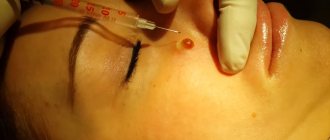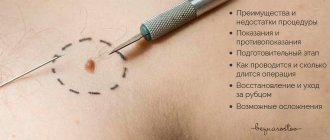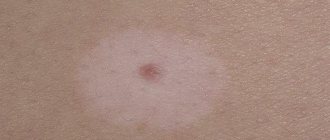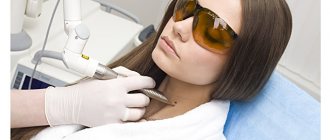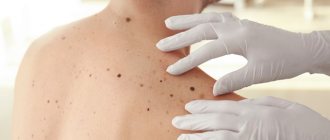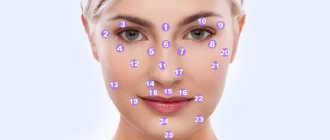When a girl's hormonal system is at its peak of activity, new moles appear on the body. Is it possible to remove moles during pregnancy or is it better to wait until the baby is born and do the procedure after childbirth? We'll talk about this below.
When a girl's hormonal system is at its peak of activity, new nevi appear on the body.
Reasons for appearance
The appearance of moles is usually associated with increased exposure to ultraviolet radiation on the skin. Another reason is hormonal imbalance. They can also form under the influence of age-related changes, for example, during adolescence. During this period, the production of individual hormones begins, which leads to the formation of nevi.
Pregnancy causes many changes in the body. One of them is a change in hormonal levels. This is why pregnant women develop moles.
After the birth of a child, the hormonal system returns to its normal state, due to which many neoplasms are eliminated. Although they may remain, and this is also a variant of the norm. If there are no adverse symptoms, there is no reason for alarm.
Should moles be removed?
Such neoplasms usually bother women more. Men treat their appearance more calmly, and sometimes even indifferently. Representatives of the fairer sex are looking for ways to remove birthmarks if they are localized on the face, the outside of the arms, or the neck. In such situations, skin doctors do not recommend using traditional methods to remove them yourself. It is better to give preference to innovative ways to combat such formations on the skin. We are talking about laser or radio wave removal, cryodestruction. These methods can be used in cases where birthmarks are constantly injured by clothing, which, in turn, contributes to infection and degeneration into melanoma. If new moles appear in a person after 40-45 years, then this is a reason to see a dermatologist.
Danger
Since the formation of moles during pregnancy is a natural phenomenon, they do not pose any danger. In most cases, they resolve themselves after the birth of the child. But even if this does not happen, in the absence of pathological symptoms there is no danger. Moles are benign neoplasms, so there is no need to worry about their presence on the skin.
But a woman should consult a doctor to make sure there are no risks. Sometimes nevi have the ability to become malignant. Since a pregnant woman’s body is weakened, there is a possibility of exacerbation of any pathologies. If there is a predisposition to cancer, then they can begin to develop during pregnancy, and the appearance of nevi becomes one of the first symptoms.
Also, the degeneration of benign formations can begin due to injury or exposure to ultraviolet radiation.
You should consult a doctor under the following circumstances: strange color of a mole or its unexpected change, itching in the area of the nevus, burning, swelling of the skin, bleeding of the neoplasm.
It is also worth consulting with a specialist if too many moles form.
Review of Safe Removal Methods
There are several methods for removing nevi, each of which has its own advantages and disadvantages:
- electrocoagulation;
- laser removal;
- cryodestruction;
- surgical removal;
- radio wave method.
The main indications for removing a birthmark are:
- A sharp increase in size.
- The boundaries have lost their clarity.
- Areas of bleeding appeared.
- Swelling and inflammation appeared.
- The appearance of crusts on the surface.
- Change in color (lost uniformity or inclusions appear).
- Inconvenient location, subject to constant trauma.
Surgical removal is a classic method that allows you to effectively eliminate the pathological focus.
The advantages and disadvantages of the method include:
- Lack of special equipment. The doctor only needs practical experience.
- High efficiency. Thanks to the wide and deep dissection, one procedure is enough to achieve the desired result.
- Relapse is unlikely. The surgeon tries to remove pathological tissue as much as possible.
- Acceptable price.
Disadvantages include:
- relatively long recovery period (1-2 weeks). It takes time for the wound to heal. It is important to avoid prolonged exposure to the sun and prohibit tanning after surgery for a month;
- scar formation;
- in case of incomplete removal, malignancy or relapse is possible;
- an allergic reaction to the local anesthetic is possible.
The essence of the operation is as follows:
- The surgeon treats the skin with an antiseptic (betadine).
- Then he administers local anesthesia to the area where the manipulations will be performed. Use lidocaine or novocaine.
No need to worry about pain relief. The anesthetic is injected locally into the tissue surrounding the nevus. Its toxicity is reduced to zero and you can safely feed your child.
- Next, a scalpel makes several cuts and removes the mole along with healthy skin.
- Stops bleeding.
- Treats with an antiseptic.
- Places stitches (the number depends on the size of the surgical wound).
- Apply an aseptic dressing.
- The obtained biological material is sent for histological examination to exclude or confirm melanoma.
We recommend reading: Pyelonephritis after childbirth: why the kidneys hurt, symptoms and treatment of pyelonephritis during lactation
Contraindications:
- presence of infection in the body;
- exacerbation of chronic diseases;
- herpes;
- the period of bearing a child and feeding. Contraindication is relative. If the effect of treatment exceeds the potential harm to the mother and child, then surgery should be performed as soon as possible.
It is recommended to perform surgical interventions with caution during pregnancy and breastfeeding due to the following reasons:
- The operation is a violation of the integrity of the skin, therefore, infection can penetrate through the wound. Antibiotics are prescribed, which is dangerous for the newborn.
- There is a chance of malignancy of an incompletely removed mole.
Surgical
In this method, the surgeon cuts out the mole using a scalpel. As a rule, malignant tumors are removed in this way or if they are suspected. After all, the method provides the opportunity to make indents during removal and preserve the formation for histological examination. Among the disadvantages, it is worth noting the traumatic nature, sutures and their removal one to two weeks after the operation, and a noticeable scar.
Cryodestruction
Advantages:
- The technique is quite simple.
- Painless.
- Short recovery period.
- Complications are unlikely.
- Can be used during pregnancy and lactation.
- No scars.
Flaws:
- a cosmetic defect is eliminated in several sessions;
- the likelihood of damaging healthy tissue.
Contraindications:
- malignant diseases;
- skin diseases;
- location on the face.
The essence of the method:
There are two options for nevus removal:
- Surface location. In this case, apply a swab soaked in liquid nitrogen for a few seconds. Nevus cells are destroyed under the influence of ultra-low temperatures. At the site of intervention, a local inflammatory reaction will develop and a crust will form, which will dry out and fall off over time.
- In a deep location, liquid nitrogen is injected with a needle deep into the underlying layers of the skin.
The method is excellent for removing tumor-like formations on the torso and limbs.
Laser removal
Technique:
After pre-treatment of the required area with an antiseptic, local anesthesia is administered. Then the doctor evaporates layers of skin with a laser layer by layer. The strength of the impact depends on the depth of the nevus.
Advantages:
- Low bleeding due to cauterization of blood vessels.
- No scars.
- Can be used on the face, chest.
- Short rehabilitation period.
Flaws:
- It is possible to carry out several sessions if the birthmark is large;
- short-term change in skin color at the site of the procedure.
Contraindications:
- Pregnancy. The skin is very sensitive.
- Diabetes. Regeneration slows down.
- Oncological diseases.
- Skin diseases.
- Irritation, rashes.
Electrocoagulation
Technique:
After treatment with an antiseptic and local anesthesia, cauterization is carried out with a special device - an electrocoagulator (or electric knife). After which a bandage with an antiseptic is applied.
Advantages:
- Speed of implementation.
- Low bleeding.
- No scars.
- If the object to be removed is small (about 1-2 mm), the procedure can be performed without anesthesia.
- Short rehabilitation period.
- Can be used on any part of the body.
Flaws:
- usually used for superficial nevi;
- slight pain after the procedure;
- there is a chance of developing a scar;
- not used for neoplasms.
Contraindications:
- Herpes.
- Oncology.
- Skin diseases.
Radio wave method
The technique involves the use of high frequency radio waves. It is the most effective and safest method. The undoubted advantage is the accuracy of the procedure, safety for surrounding tissues, short duration of the procedure, and the possibility of use in difficult places (eyelids).
Contraindications:
- infectious diseases, the presence of a focus of inflammation;
- oncology;
- diabetes;
- glaucoma;
- skin diseases.
Increase in size
Although new moles during pregnancy are not dangerous, some caution is required. It is necessary to pay attention to emerging negative symptoms. One of them is increasing size. This may be a sign of infection or degeneration into a malignant tumor. In this case, you need to observe not only new growths, but also those that were on the body before.
If the mole has increased in size, you need to talk to your doctor and get examined. It is especially important to do this if there are additional adverse symptoms, such as pain, itching, bleeding.
Unfavorable symptoms do not always indicate disease. The growth of a nevus or a change in its color can be explained by hormonal changes in the body. But sometimes these changes trigger an oncogenic process, which can be very dangerous. Therefore, you should undergo an examination.
Can they disappear on their own over time?
You should not panic if new pigment spots appear on your body during pregnancy or after childbirth. There is a high probability of their disappearance on their own after normalization of hormonal levels. Stages of education regression:
- A white rim appears around the pigmented spot.
- It gradually increases in size.
- The stain becomes discolored. A small whitish mark remains in its place.
Reasons for regression of age spots and moles:
- Severe sunburn.
- Hormone levels normalized.
- Dermatological disease vitiligo.
Only formations with a smooth surface can disappear without a trace after childbirth. Lumpy ones rarely regress.
Preventive measures
The formation of a nevus during gestation is considered normal. But under the influence of unfavorable factors, problems may arise. Therefore, it is worth taking precautions.
These include:
- Protecting the tumor from sunlight. Exposure to ultraviolet radiation can cause cells to degenerate into a malignant tumor. And since a pregnant woman’s immunity is weakened, the risk increases. Therefore, moles on the body should be covered with clothing. You should also refrain from visiting the solarium and sunbathing.
- Prevention of injury. If the integrity of a mole is damaged, an infection may enter the bloodstream. The inflammatory process can cause growth in the size of the tumor and its degeneration into a malignant tumor. Therefore, it is necessary to prevent mechanical damage to the surface.
Areas of skin where there are nevi should not be scratched. This can lead to injury and infection. If the formation itches, you need to be examined. The appearance of fluid in the tissue of a mole is also a cause for concern. It is unacceptable to squeeze it out.
Are nevi dangerous when carrying a child?
Moles during pregnancy do not pose a danger to the female body. They are benign formations that appear on the skin.
Nevi (the scientific name for growths) can be congenital or acquired. The latter can appear at any time.
There is no need to worry about formations occurring. They are benign tumors, so they cannot harm the body.
But in some cases, nevi can really cause harm. This doesn't happen often, but it does happen. There may be a process of degeneration of the growth into a malignant one.
This process is triggered by:
- genetic predisposition;
- tissue injury;
- ultraviolet.
Doctors note that moles appear when there is an excessive accumulation of melanocytes. They are cells that synthesize melanin. With excessive localization of cells, nevi are formed.
If moles appear during pregnancy, there is no need to worry. After all, benign formations will not harm the mother and the unborn baby. Then large accumulations of nevi should not be a concern.
In some cases, a mandatory consultation with a doctor is necessary. This is important when the mole:
- increases;
- itches;
- changed color;
- bleeding.
For any altered conditions, it is important to conduct a full examination of the formation. This will require consultation with a dermatologist or oncologist.
Is deletion allowed?
Removing moles during pregnancy is not advisable. This is explained by the fact that some of them may disappear after stabilization of hormonal levels. This is also due to the unpredictability of the consequences of any intervention in the body. If in normal conditions recovery after surgery to remove a nevus occurs easily, then the expectant mother may experience problems. It is also unknown how such exposure will affect the child.
However, such procedures during gestation are not prohibited. Mole removal is carried out using minimally invasive methods that have almost no effect on the body. During the manipulation, local anesthetics are used, which are considered safe. Therefore, there are no direct contraindications for intervention, and skin growths can be removed.
In some cases, mole removal is necessary. The procedure may be prescribed under the following circumstances: the likelihood of trauma to the tumor, the location of the nevus in the perineal area, a high risk of degeneration into a cancerous tumor.
These situations pose a risk to the health of both the woman and the child. Therefore, it is better to remove the tumor. But the decision about this must be made by the doctor, having assessed the features of the clinical picture.
Preventing mole changes
Preventive measures boil down to compliance with the following rules:
- Reducing insolation time.
- Avoid wearing tight, uncomfortable clothes and shoes.
- Avoid solariums.
- Monitor the condition of your skin. Includes the use of moisturizing and skin-nourishing cosmetics.
- Periodic examination of the entire body for changes in birthmarks.
- Remove suspicious nevi located in areas with a high risk of damage.
Sources
- https://ProMelanin.ru/rodinki/udalyat-pri-beremennosti.html
- https://barberjonny.ru/rodinka-vyrosla-vo-vremya-gv-mozhno-li-udalyat-rodinki-pri.html
- https://meddnayka.ru/posle-rodov-poyavilos-mnogo-rodinok-na-tele-prichiny-i-neobhodimost-diagnostiki-poyavleniya-rodinok-posle-beremennosti.html
- https://polevskoy-adm.ru/mozhno-li-pri-gv-udaljat-rodinki/
- https://rodinkam.net/obnov/posle-rodov-poavilos-mnogo-rodinok-na-tele/
- https://ProMelanin.ru/rodinki/posle-rodov.html
- https://beremennost.net/pochemu-posle-rodov-poyavilos-mnogo-rodinok
- https://okoge.ru/story/pochemu-posle-rodov-poyavilos-mnogo-rodinok
- https://mamochkaiya.ru/posle-rodov/poyavlenie-rodinok-pri-beremennosti.html
[collapse]
Myths
The formation of moles during gestation is a common phenomenon. Due to the lack of knowledge on this issue, women began to come up with their own explanations for this process. Most of them have not been scientifically confirmed, but are still popular among the population.
Such myths include:
- If, while carrying a child, a mole forms on the body of the expectant mother, then the baby will also have one, and in the same area. There is no evidence to support this opinion. Most children emerge with clear skin without any growths. They begin to form by adolescence, and their location can be any. Although, if there is a genetic predisposition, a similar outcome is possible, and if the mother had many moles, they may appear in the child.
- Based on the location of the nevi, predictions can be made regarding the fate of the mother and baby. This myth is also not confirmed. There is no relationship between skin spots and life events.
- A pregnant woman can cause nevi to appear on the baby's body. This is supposedly possible if, in severe fright, she grabs some part of her body. According to myth, the baby will form a birthmark in this place. But this assumption is wrong. Expectant mothers should not worry about this; in their condition, it is harmful to worry.
Moles on the body are a harmless phenomenon, even if they form in a pregnant woman. This is due to changes in hormonal levels. When it returns to normal, most of the tumors will disappear. Those nevi that remain are also not dangerous if they are not accompanied by pathological symptoms. Removing moles during pregnancy is rarely practiced if there is a threat to the health of the mother and baby.
When should you see a doctor if moles appear?
If after childbirth you have moles or nevi that are susceptible to frequent trauma or friction, then to prevent complications it is better to make an appointment with a dermatologist. Also, if several or even one mole begins to grow, increase in size and over time rises more and more above the skin, it is worth visiting a doctor. A qualified specialist, after examination and based on the results of examinations, will prescribe a method with which you can get rid of pathologically developing moles and nevi. Often this is surgical excision, cryodestruction, or laser or radio wave removal of the formation. The patient will be prescribed to undergo simple and short-term therapy until the scar heals. This treatment is necessary to prevent infection of the wound.
Is it possible to remove nevi during pregnancy?
Carrying out surgery to remove a mole during pregnancy is not recommended, but is not prohibited. Only doctors can make the final decision after weighing all the pros and cons. Laser removal is usually recommended for expectant mothers. It is performed under local anesthesia. Surgical excision is performed only if cancer is suspected.
It is definitely necessary to remove a mole if the doctor finds signs of degeneration into a malignant formation. Doctors study it and decide whether to cut it out now or wait until childbirth. They also be sure to weigh the risks for mother and baby, but usually the risk of cancer is much higher.
It is also recommended to get rid of nevi that are susceptible to increased trauma. If a mole may be damaged when changing clothes or bathing, it is better to remove it. Frequent damage can provoke oncological degeneration.
Many have encountered freckles, moles, and warts. But what exactly do you need to know about moles?
Moles or nevi
As a rule, these are small brown rashes on the body that are formed during the proliferation of special cells - melanocytes. It is these cells that are responsible for the production of the substance that colors the skin. Moles can appear suddenly and at any age, and some can disappear on their own. Very often you can hear that moles easily turn into cancerous tumors, but in most cases, nevi are ordinary benign neoplasms. And if not, then moles can be treated surgically without any problems.
Sometimes it happens that moles in pregnant women begin to grow and increase in size. And the expectant mother is concerned about the question: is it possible to remove moles for pregnant women? To reassure herself and not harm the baby, a woman should know that moles are different, and each case requires a special approach, especially during pregnancy.
Types of moles
On the skin, in addition to the usual small moles, you can also find others that differ in the location of melanocyte cells in the skin.
- Borderline nevus. It can be located on any part of the body and looks like a dark mole that protrudes slightly above the surface of the skin.
- Complex noncellular nevus. Typically, such moles can be found on the back and shoulders in adolescence. Very often, such moles disappear by the age of 60. A nevus looks like a light brown mole that protrudes quite a lot above the surface of the skin. Such moles can have a nodular shape, and hairs can also grow from them. Such a mole should alert you when you feel itching or pain.
- Intradermal nevus. A no different type of mole is found in the majority of the adult population.
- Galonevus. It is an ordinary mole, which is surrounded by a pale halo. The presence of a pale zone does not promise anything malignant.
We suggest you read How to get rid of wrinkles on the forehead
Very often, a mole can be confused with a wart. But over time, the wart increases in size, has an uneven surface, and a narrow base. We can say that the wart seems to be stuck to the skin. But an increased size or a change in color does not mean unsafe. But for the sake of aesthetics, such warts can be removed.
Melanoma
Only by studying the required amount of information and visiting a dermatologist can you find out whether a mole is ready to degenerate into a malignant one. But only half of cancerous degenerations are associated with moles; the remaining cases are considered in connection with the harmful effects of ultraviolet rays.
INTERESTING! Scientists suggest that it is ultraviolet radiation that changes the DNA of cells.
https://www.youtube.com/watch?v=4q_FgHF7-II
Let's determine who is more susceptible to melanoma:
- Women (melanoma is less common in men because women have the hormone estrogen).
- Persons with light skin (it is this skin that is susceptible to trauma due to the small number of melanocytes).
- People who like to sunbathe or work outdoors.
- Those who have suffered burns (UV rays contribute to the degeneration of skin cells).
A mole or nevus is a pigmented spot on human skin, less often it can be observed on the mucous membranes. They are formed due to the high concentration of melanocytes in the cells of the upper epidermis. Women experience more age spots due to the many hormonal changes that occur in their bodies throughout life, especially during pregnancy and breastfeeding.
A large percentage of women notice that they have moles during pregnancy, and this causes serious fears and concerns. But this is a natural process, given the large-scale hormonal changes that occur in the female body at this time.
During pregnancy, the glands produce a double portion of all hormones so that they are sufficient for the functioning of the female body and for the proper development of the child.
Against this background, new age spots appear or old ones begin to grow, as evidence of the proper functioning of the hormonal system.
Over time, after the birth of the baby, the body recovers and the hormonal levels return to their normal state.
Therefore, during pregnancy you should not worry too much and count nevi - any changes in them only indicate a restructuring in the body.
You should only worry when excessive changes are noticed - the pigmentation has become too large, has changed color or structure. If something similar is observed, this is a reason to consult with a leading gynecologist and make an appointment with an oncologist. According to statistics, abnormal malignant changes during pregnancy occur 1 time in 100,000 cases.
What are the reasons for visiting a dermatologist? Doctors use the Arcode system, an acronym that consists of five different signs of convex nevi. These include:
- A - asymmetry: if you mentally draw a line in the center of any mole, then on both sides there will be equal halves of the pigment spot. When abnormal cells appear inside the pigmentation, it loses its symmetry and equal halves will no longer work.
- P - size: if active growth of spots begins, then they should be carefully monitored. Large pigmentations are more dangerous than small ones, as they often degenerate into melanoma. This is especially true for the abdominal and neck areas. If a woman’s mole grows more than 6 mm during pregnancy, this may be a symptom of the development of melanoma.
- K - edge: the borders of healthy nevi have clearly defined edges, and any irregularities, wavy or jagged contours are alarming symptoms.
- O - color: the color of age spots should not change in a person during life. In pregnant women, nevi often darken, which is a pattern - a large amount of melanin accumulates in the upper layer of the epidermis as a result of a hormonal surge. Because of this, both the breast halos and the navel darken in pregnant women. You should consult a doctor if the mole has darkened sharply and its color has become more black than brown.
- “D” - dynamics: if abnormal cells appear, cracks, bleeding, crusts or peeling appear - all these are reasons for immediate contact with a dermatologist and oncologist.
If at least one of the symptoms is observed, you should first contact a gynecologist who is managing the pregnancy. He must write out a referral to a dermatologist, who will examine the pigment spot and give his opinion.
If necessary, the dermatologist will also write a referral to an oncologist for a consultation. An excellent solution would be to make an appointment with a practicing dermatologist-oncologist, who will conduct an examination and take the necessary tests.
Many women online say that they have new moles on their body after childbirth, to which they receive alarming reviews about skin cancer and advice to urgently go to an oncologist. Should we panic? Hormonal changes begin in the female body with the conception of a child and stop only after breastfeeding stops, i.e., they continue for 2–3 years.
The appearance, disappearance or change in the structure of moles throughout this time is normal. After childbirth, several new spots often appear on the body, which may disappear within 2-3 years, or may remain forever - it depends on the individual characteristics of the body. Just like the number, color and location of new pigment spots depends.
If during pregnancy a woman is characterized by an increased amount of hormones that help bear and form a child, then after childbirth the amount of hormones that promote breastfeeding sharply increases.
In any case, their appearance is a physiological process and there is no need to worry about it.
Where to go
If a woman notices that she has suspicious-looking moles, it is best to inform the gynecologist who is monitoring the pregnant woman. If necessary and if there are any suspicions, the doctor will definitely prescribe an examination and refer you for a consultation with an oncologist.
You should not go to a beauty salon with this problem. Not all beauty salon specialists have sufficient qualifications, and are unlikely to be able to distinguish a darkened nevus from melanoma. And incomplete removal of a degenerated mole leads to its reappearance and a more severe course.
The formations removed in medical institutions are subjected to cellular examination, after which the patient will receive an accurate answer as to whether the mole is a malignant tumor or not. In addition, in case of a positive result, the doctor monitors the woman’s condition, gives recommendations, and conducts a preventive examination.
Only a specialist doctor should examine the tumor
Reasons for the formation of new moles
During pregnancy, a woman's hormonal background changes. Coupled with exposure to ultraviolet radiation, this provokes increased growth of moles. During this period, old nevi may noticeably increase in size, and new ones appear on any part of the body. But there is no need to worry - they often disappear on their own towards the end of the breastfeeding period.
Most moles appear in the second trimester. Usually these are harmless dark spots that disappear over time and do not deserve close attention.
Although you shouldn’t worry about every mole, you need to know that the reasons for contacting a doctor are:
- Itching and pain in the area of the spot;
- Rapid growth of nevus;
- Redness and peeling of the skin around the mole;
- Discharge of blood or colorless liquid from this formation;
- Changes in the structure of the nevus.
Moles can be very different: from slightly red and small, blue and pink, to large and black. But, despite this, what scares people most is not the dark, convex nevi from which hairs grow, etc., but simple hanging moles. Such moles seem harmless in appearance:
- For the most part they are light in color, pink or white, but can be a little darker;
- As a rule, they are small,
- They resemble small papillae.
However, subconsciously, moles scare everyone, perhaps because of the danger of tearing off such a mole. Hanging moles do not represent anything special that would be worth “clinging to”: they are simple moles formed from the epidermis under the influence of melanin.
The peculiarity of appearance is just a feature of convex moles, which are often classified not only in nevi, but also in the group of papillomas, and therefore it is believed that if a lot of hanging moles begin to appear, then a person may develop the human papillomavirus. In fact, it is impossible to speak specifically and confidently about this; only a doctor can solve this issue, so if you have any questions, you should not try to diagnose yourself; you should consult a dermatologist.
Very often, new moles appear in teenagers and pregnant women. If teenagers are less interested in their health, then a pregnant woman may be disturbed by any change in the body or in the body. So women are very interested in why hanging moles appear during pregnancy. It's all about changes in hormones in the body: at this time, hormonal surges most often appear and are observed, regardless of your goals.
Everyone is interested in what is the main reason for the appearance of hanging moles on the body. However, each person will have their own reason, depending on the specific situation and the characteristics of the processes in the body.
- Hormonal changes. As already noted, hormones strongly influence the formation of new hanging moles. Hormonal levels change greatly, primarily during pregnancy. For this reason, the formation of new hanging moles in pregnant women is not nonsense, but a completely normal phenomenon, which many women know about. Also, hanging moles often appear in adolescents when hormones are “boiling,” and in people who have recently started taking hormonal medications, for example, for medicinal purposes for medical reasons.
- Aging. This is still just an American theory of moles rash on the body. According to her, the reasons for hanging moles on the neck, back, armpits and other parts of the body are that the body aging very quickly and it is necessary to take action. Russian scientists have not yet refuted, but have not confirmed this option for the appearance of new moles on the body.
- Human papillomavirus. To determine whether the rash of moles on your body is really associated with this virus, you need to see a doctor and get the necessary tests.
- Ultraviolet. This is one of the most striking and common reasons for the appearance of moles on the body, not only during pregnancy. For this reason, any dermatologist will give you useful recommendations on how to prevent the appearance of new moles (especially in the summer): in the summer, try to avoid exposure to the sun from 10 to 16 pm, wear closed clothes, use sunscreens or sprays, do not forget wear sunglasses and a hat.
INTERESTING. New hanging moles most often appear on exposed areas of the body that are often exposed to sunlight, especially direct sunlight. Most often, these are the face, arms, shoulders and back.
We are talking about whether the appearance of new hanging moles on the body of a pregnant woman is dangerous. Oddly enough, it is during pregnancy that women notice new or first hanging moles on their bodies. There is nothing strange about this, especially if pregnancy occurs in the summer. The female body changes while bearing a child, causing a woman's hormonal background to change, accompanied by a surge of hormones.
We suggest you read How to relieve itching during pregnancy
By themselves, hanging moles are just benign neoplasms that can rarely indicate the negative impact of their presence. In fact, a benign mole will not degenerate into a malignant formation if it is not torn off, rubbed, tugged at or touched. However, there is a risk of a harmless nevus degenerating into a dangerous melanoma, so it is worth periodically inspecting changes in hanging moles. Here's what should get your attention:
- The appearance of pain in the area of the mole, as well as when touching it,
- An increase in size of a mole, albeit quickly in a short period of time,
- Darkening or redness of the mole,
- Bleeding of the mole or discharge of clear fluid,
- Itching of the mole, burning inside or around it,
- Formation of a strange spot around a hanging mole,
- A drooping nevus, which looks like a hanging mole turning into a pedunculated mole.
If you observe the same symptoms, you need to consult a doctor as soon as possible, as if you tore off a hanging mole. A dermatologist will examine the nevus and decide whether there is a need to remove this mole, whether it is dangerous and what should be done.
First of all, understand that hanging moles during pregnancy are no worse or more dangerous than simple flat or convex moles. But be more attentive to their manifestations, which will make your life much easier and allow you to relax your nerves.
The neck is a favorite place for moles. However, their danger is that if you forget, you can scratch the mole so that you scratch or tear it off, especially if you have long nails. What to do if you still rip off a mole?
- Be sure to cauterize the mole with a 3% hydrogen peroxide solution;
- If bleeding is observed, then after cauterizing the mole with peroxide, it is necessary to apply gauze or a bandage to the site of injury. Fold the bandage so that it will contain the bleeding. You will have to keep the bandage or gauze on the injury for about 10 minutes;
- If there is no bleeding, simply apply cotton wool soaked in hydrogen peroxide to the injured area, dry it slightly and lubricate the wound with brilliant green;
- Even if there is no bleeding, see a dermatologist or oncologist to check the mole's reaction to injury.
We advise owners of moles in the armpit area to shave more carefully so as not to accidentally cut off a mole. In addition to the fact that this is dangerous due to the degeneration of the mole, you can also introduce infection or dirt, both from the razor blade and from sweat. It is the armpits that are famous for storing bacteria and microbes in large quantities, which can easily get into the wound if shaving improperly.
By the way, for those who accidentally not only scratched or tore off a mole, but cut it off completely, we advise you not to throw away the nevus, but to wrap it in gauze or a bandage and take it to the doctor as soon as possible so that the cut nevus can be submitted for analysis.
Many expectant mothers are frightened by the appearance of hanging moles during pregnancy. As a rule, such formations are small in size and have a pinkish color. They do not pose a threat to your body and appear for the same reason as ordinary nevi.
Sometimes red moles may appear on the skin. This is a sign of a vascular tumor, which is formed from blood vessels. While carrying a baby, not only the balance of hormones in a woman’s body changes, but also the subcutaneous blood vessels. There is no need to worry about red growths. You just need to track changes in color and size. If there is a rapid increase in nevus, then you should consult a doctor.
The papilloma virus that appears on the body of the expectant mother should be distinguished from birthmarks. It appears as a brownish growth on the neck, abdomen or face. Currently, there are no exact reasons for the appearance of papilloma during pregnancy, however, this neoplasm is benign, so you should not pay much attention to it.
What is a hanging mole and how to treat it
Hanging nevi occur quite often during pregnancy. Many experts attribute them to infection with the papillomatosis virus, but an accurate diagnosis can only be made after examination and testing.
These formations tend to appear in the most inconvenient places: in the crotch, armpits, under the breasts, on the neck. They can form small clusters, or can reach a size of several centimeters. Most hanging moles disappear in the first months after the baby is born and do not require outside intervention. When it is necessary to “sound the alarm” and draw the attention of a gynecologist to the problem:
- the nevus has reached a large size, affecting the quality of life,
- the mole is subjected to systematic trauma,
- thickening and darkening of the formation,
- pain, itching, numbness at the location of the mole,
- bleeding
Other cases, including aesthetic ones, are postponed until the postpartum period.
Hanging growth is often injured

